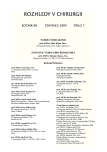Necrotizing Infectious Complications in Diabetic Foot Syndrome and their Solutions
Authors:
R. Ston; J. Weiss
Authors‘ workplace:
Chirurgická klinika 3. LF UK FNKV Praha, přednosta: prof. MUDr. R. Gürlich, CSc.
Published in:
Rozhl. Chir., 2009, roč. 88, č. 7, s. 381-386.
Category:
Monothematic special - Original
Overview
Background:
Diabetic foot syndrome affects an increasing percentage of the population as the incidence and prevalence of diabetes increases. In some cases of the disease, acute necrotizing infectious complications can be observed to the extent that they require acute and extensive surgery débridement, often across anatomical structures. Local treatment is always preceded by vascular examination, possibly limb revascularization.
Methods:
After open necrectomy, which frees the patient from infectious focus and necrotic tissue, and which, in some cases, is the last resort to preserve the limb’s length, there is, in the second period (after the acquisition of granulation tissue in the defect), a need to close the defect. It is possible to let small areas heal spontaneously through epithelialisation from the edges of the wound, however, major defects have to be close either operationally with secondary suture or with dermoepidermal skin-grafting. Secondary suture requires a local shift or additional resection of the bone to obtain sufficient material for wound closure. Skin graft respects the requirement to preserve the maximum of healthy tissue while not slowing down the closure of the wound in large defects.
Results:
Autotransplantation of secondary wound with dermoepidermal skin-graft after the debridement of necrotic tissue was performed in 16 patients. The average age was 58 years, the average surface of skin-grafting was 100 cm2, the interval between transplantation and debridement was on average 21 days and from skin-grafting to the healing, of 62 days. 14 patients were completely healed; one patient suffers chronic osteomyelitis, and another one a smack chronic defect in the periphery of the graft. Transplants affecting the plant were localized outside the zone of the foot that bears the most of the body’s weight.
Conclusion:
Local treatment of infectious complications in necrotizing diabetic foot syndrome is important for managing the acute condition and preservation of limb function. It is appropriate to centralize the treatment to podiatric centers cooperating closely with the surgeon specializing on wound healing and diabetic foot.
Key words:
diabetic foot syndrome – necrotizing infection – surgical debridement –dermoepidermal skin – grafting
Sources
1. Malgrange, D. Physiopathology of the diabetic foot. ev. Med. Interne, 2008 Sep; 29 Suppl. 2: S231–7. Review
2. Stiegler, H. Diabetic foot syndrome. Herz, 2004 Feb; 29(l): 104–115.
3. Zgonis, T., Stapleton, J. J., Girard-Powell, V. A., Hagino, R. T. Surgical management of diabetic foot infections and amputations. AORN J., 2008 May; 87(5): 935–946; quiz 947–950.
4. Plodr, M., Vacková, M. Deep necrotizing soft tissue infections. Necrotizing fasciitis and necrotizing myositis. Epidemiol. Mikrobiol. Imunol., 2002 Nov; 51(4): 156–160.
5. Plodr, M., Čermák, P., Ferko, A. K problematice klasifikace infekcí měkkých tkání. Rozhl. Chir., 2006, roč. 85, č. 11, s. 560–565.
6. Zeman, et al. Chirurgická propedeutika. Praha: Galén, 2000, 74–81.
7. Mahmoud, S. M., Mohamed, A. A., Mahdi, S. E., Ahmed, M. E. Split-skin graft in the management of diabetic foot ulcers. J. Wound Care, 2008 Jul; 17(7): 303–306.
8. Cunha, B. A. Antibiotic selection for diabetic foot infections. J. Foot Ankle Surg., 2000 Jul-Aug; 39(4): 253–257.
9. Ambrosch, A., Lehnert, H., Lobmann, R. Microbiological aspects and antibiotic therapy of diabetic foot infections. Med. Klin. (Munich), 2003 Apr 25; 98(5): 259–265.
10. Dalla Paola, L., Faglia, E. Treatment of diabetic foot ulcer: an overview strategies for clinical approach. Curr. Diabetes Rev., 2006 Nov; 2(4): 431–447.
Labels
Surgery Orthopaedics Trauma surgeryArticle was published in
Perspectives in Surgery

2009 Issue 7
Most read in this issue
- Septic Shock in a Patient with the Fourniér Gangrene with Fatal Outcome
- Complications of IPOM Plasty – Our Experience
- The Complication of a Periproctal Abscess – Fourniér’s Gangrene or Necrotizing Fasciitis? A Case Report
- Anti- biotic Prophylaxis in Urology
